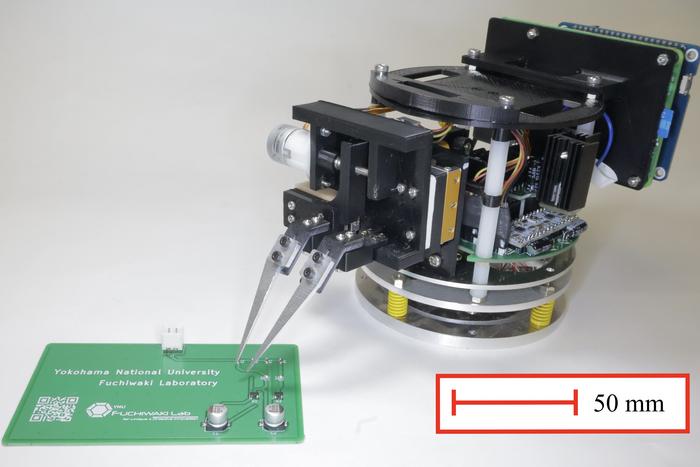
Engineers and researchers at YOKOHAMA National University have unveiled a groundbreaking innovation in robotics with the development of the Holonomic Beetle 3, a tiny, untethered autonomous mobile micromanipulator. This state-of-the-art robot is designed to perform intricate tasks in confined and hazardous environments, offering unprecedented levels of precision and adaptability. As the name suggests, the design of HB-3 takes its inspiration from the remarkable movements and anatomy of the rhinoceros beetle—an organism known for its extraordinary maneuverability and strength relative to size.
The HB-3 robot is both compact and lightweight, weighing a mere 515 grams and occupying only 10 cubic centimeters of space. This miniature design is made possible through advanced engineering techniques that prioritize energy efficiency and spatial optimization. By harnessing piezoelectric actuators, the HB-3 can execute highly precise movements that were once seen as unattainable for robots of this scale. Through this technology, it can manipulate and interact with a wide array of tools and tasks, achieving an average positioning accuracy of 0.08 mm along the x-axis and 0.16 mm along the y-axis.
A significant breakthrough associated with HB-3 is its autonomy and ability to operate cordlessly. Traditionally, robotic devices have faced limitations in both mobility and functionality due to the dependency on cumbersome power supply systems and tethered controls. The innovative design of HB-3 integrates an advanced single-board computer into its architecture, effectively eliminating the constraints imposed by power cables. This means that the robot can navigate complex environments and perform tasks with a degree of freedom that was previously unattainable for mobile micromanipulators.
The implications of the HB-3’s abilities are vast and multi-faceted, particularly in fields such as laboratory automation, medical procedures, and scientific research. As industries strive for the ability to manipulate materials on a micro or even nano scale, the capabilities of this robot meet an ever-growing need for precision in scenarios where human participation is limited or impractical. Whether it’s operating in vacuum chambers, clean rooms, or in the presence of biohazard threats, the need for autonomous robots capable of executing complex tasks cannot be overstated.
Furthermore, the HB-3 employs machine learning algorithms that allow it to refine its operations in real time. This adaptability is a significant advancement over traditional micromanipulators, which lacked the capability to adjust their actions based on real-time feedback. With an integrated camera, HB-3 can detect and respond to its environment, thereby enhancing its effectiveness during operations across a variety of tasks. This technology marks a shift toward creating more intelligent robots that can learn and adapt to their surroundings, making them invaluable assets in numerous settings.
In extensive testing scenarios, the HB-3 has showcased a remarkable ability to complete an array of tasks utilizing different tools, such as tweezers to place chip components or injectors to apply precise droplet quantities. Impressively, the robot completed 87 percent of the tasks with success, highlighting a level of efficiency that could transform how precision work is approached in both research and industrial domains. Furthermore, the flexibility of the tools that can be integrated with the HB-3, including measurement probes and soldering irons, broadens the scope of its applications, enabling it to serve various functions across multiple disciplines.
Despite these advancements, the team of engineers and researchers at YOKOHAMA National University is committed to enhancing the capabilities of the HB-3 further. Their ongoing research aims to fine-tune the robot’s processing speed, which is currently limited by the Raspberry Pi CPU it relies upon. Looking toward the future, they are exploring the potential for offloading demanding tasks—like object detection—to higher-performance external computers, which could enable even greater functionality and versatility.
The pursuit of improved speed and precision is not solely about enhancing current capabilities; it also encompasses innovative adaptations that could increase the latter’s accuracy. Researchers are investigating the integration of side-view and top-view cameras to enhance the z-axis positioning accuracy. Such developments could facilitate a new era of precision robotic operations in confined spaces where human intervention is impossible or impractical.
The HB-3 project illustrates the remarkable potential of robotics in solving critical challenges across various industries. It underscores the intersection of engineering and biological inspiration, drawing direct parallels between the natural adaptability of organisms and the capabilities of engineered machines. By blending cutting-edge technology with bioinspired design, YOKOHAMA National University’s research teams are pioneering solutions that resonate with the needs of modern scientific inquiry and manufacturing processes.
The significance of such developments extends beyond the immediate technical achievements. As industries increasingly turn to automation and advanced robotics, the emergence of sophisticated, autonomous robots like the HB-3 paves the way for innovations that could redefine operational standards within laboratory and industrial settings. Robotics isn’t just a niche area of engineering; it is becoming a critical lifeline for scientific progress, medical advancements, and manufacturing efficiency.
As this research progresses, interest is anticipated to grow not only within academic circles but also among business leaders and policymakers who recognize the potential impact of robotics on society. As robotics and automation technologies continue to evolve, such innovations will likely inspire new applications and partnerships across sectors, further driving growth and innovation in the realms of science and engineering.
The story of the HB-3 is not merely about a new robot; it is a testament to human ingenuity and the relentless pursuit of pushing boundaries. It emphasizes the importance of continual research, innovation, and collaboration among scientists and engineers to overcome existing challenges and create solutions that can benefit humankind across all spheres of life.
—
Subject of Research: Development of an autonomous mobile micromanipulator
Article Title: Untethered Autonomous Holonomic Mobile Micromanipulator for Operations in Isolated Confined Spaces
News Publication Date: 26-Jan-2025
Web References: https://advanced.onlinelibrary.wiley.com/doi/10.1002/aisy.202400872
References: [None provided]
Image Credits: YOKOHAMA National University
Keywords
Autonomous robots, micromanipulation, piezoelectric actuators, robotics, machine learning.
Tags: advanced engineering techniquesautonomous mobile micromanipulatorconfined environment roboticsenergy efficient roboticshigh positioning accuracy in robotsHolonomic Beetle 3lightweight robot technologyminiature roboticspiezoelectric actuators in roboticsprecision tasks in roboticsrhino beetle inspired robotuntethered robotic systems





